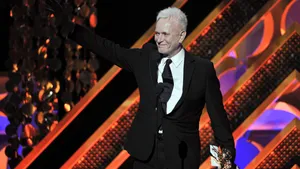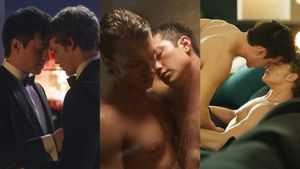LGBTQ+ people have long been a mainstay of Broadway, like our cover star Wayne Brady. Whether it’s because LGBTQ+ people are particularly drawn to the performing arts, have found more acceptance there than elsewhere, or some other reason, it’s clear, to paraphrase a lyric from Spamalot, you won’t succeed on Broadway if you don’t have any gays.
Keep up with the latest in LGBTQ+ news and politics. Sign up for The Advocate's email newsletter.
But Broadway, like other forms of mainstream entertainment, has been slow to tell LGBTQ+ stories, at least to tell them sympathetically or accurately. “Broadway” became shorthand for New York City’s theater district early in the 20th century, but until the 1970s and ’80s, Broadway plays and musicals mostly ignored the existence of LGBTQ+ people or pathologized them; there were many queer creators and performers, but homophobia was more powerful than they were. Now we’ve come to an age of unprecedented representation. Here is a look at what led up to that.
Queers on Broadway
In the first half of the 20th century, Broadway audiences saw the occasional coded queer character, often the subject of jokes, or negative representations. The Green Bay Tree (1933) by Mordaunt Shairp centered on a “half-suggested homosexual relationship,” as New York Times critic Brooks Atkinson put it, between a wealthy man and his adopted son. Lillian Hellman’s hit The Children’s Hour (1934) had two teachers “accused” of being in a lesbian relationship, and when one (spoiler alert) admits she has romantic feelings for the other, well, it ends badly. Tea and Sympathy (1953) saw a concerned housemother attempt to “save” a young male student from being gay. The groundbreaking musical West Side Story, first produced in 1957, had a butch girl, Anybodys, as part of the Jets street gang; the 2021 film version portrayed the character as a transgender boy.
The 1960s didn’t liberate everyone. The Boys in the Band was produced off-Broadway in 1968, but it didn’t come to Broadway until 2018 (with an all-queer cast). Some LGBTQ+ activists have seen the show by gay playwright Mart Crowley as a negative portrayal of gay men — self-loathing, prone to alcoholism — but the Broadway production and a 2020 Netflix film brought a reevaluation, with some recognizing the characters’ courage in facing a homophobic world. The hippie musical Hair, which hit Broadway in 1968, included gay and fluid characters in its embrace of peace, love, and freedom for all. Cabaret (1966) downplayed gay themes from the source material, but the later film and revivals have upped the gayness.
The great (and gay) composer-lyricist Stephen Sondheim’s landmark musical Company premiered in 1970. Some theatergoers read the central character, Bobby, as gay — he’s a single man surrounded by couples encouraging him to find a mate — but the script by George Furth doesn’t say he is. There was gay representation in a 21st-century reimagining; more about that later.
Small steps
As the 1970s went on, there was progress, mostly involving gay men, leaving out lesbians and trans people. In 1975, Terrence McNally’s hilarious farce The Ritz had a straight man targeted by the mob hiding out in a gay bathhouse — and Rita Moreno adding to the comedy as entertainer Googie Gomez. The year also saw the premiere of one of Broadway’s biggest hits, A Chorus Line, with gay inclusion among the auditioning dancers and direction and choreography by Michael Bennett. In 1979, there was Martin Sherman’s Bent, about the persecution of gays in Nazi Germany.
Lanford Wilson’s gay-inclusive Fifth of July, a kind of precursor to The Big Chill, came to Broadway in 1980. In 1982, Harvey Fierstein played a lovable gay man (and drag performer) in Torch Song Trilogy, which he wrote. 1983 brought La Cage aux Folles, a musical remake of the popular French play and film about a gay couple pretending to be a heterosexual pair when their son becomes engaged to a woman from a conservative family. The gay talent involved included Fierstein, who wrote the book (the script), director Arthur Laurents, and composer-lyricist Jerry Herman of Hello, Dolly! fame. Its song “I Am What I Am” became an LGBTQ+ anthem.
How the AIDS crisis affected Broadway
AIDS was ravaging gay and bisexual men, and trans women, in the 1980s and early 1990s; the disease got a full dramatic treatment, along with American society in general, in Tony Kushner’s epic Angels in America in 1993. Larry Kramer’s AIDS drama The Normal Heart had premiered off-Broadway in 1985 but didn’t come to Broadway until 2011. McNally’s Love! Valour! Compassion!, about a group of gay men gathering at a country home, opened in 1995; it focused on their friendship but couldn’t avoid the subject of AIDS. Jonathan Larson’s musical Rent, about bohemian life in New York, began a long Broadway run in 1996; it included gay, lesbian, bisexual, and trans characters, with some, including a straight woman, affected by the pandemic.
The new century has brought almost too many LGBTQ-focused or inclusive shows to list. Kinky Boots, about a shoemaker saved by drag queens, premiered in 2013, with a book by Fierstein and songs by Cyndi Lauper. Hedwig and the Angry Inch, with a trans woman as protagonist, got a Broadway production in 2014 after having opened off-Broadway in 1998. Fun Home, based on Alison Bechdel’s autobiographical graphic novel about the lesbian daughter of funeral home operators, became a Broadway musical in 2015.
Lesbian playwright Paula Vogel had Indecent, a musical about a lesbian-themed play and censorship, on Broadway in 2017, then the gay-inclusive Mother Play this year. Recent years have brought Avenue Q, Slave Play, A Strange Loop, The Prom, and more. A musical version of The Color Purple didn’t downplay the lesbian relationship as the 1985 film did, and a new imagining of the classic comedy Some Like It Hot had one character going beyond drag to embracing a new identity as a trans woman. And a 2021 production of Sondheim’s Company made the single character a woman, Bobbie, and one of the couples a gay male pair.
And today
There have been many more LGBTQ-inclusive shows; this isn’t an exhaustive list. And here’s a nod to numerous other LGBTQ+ Broadway creators and performers, each of whom deserves an essay of their own. Besides Sondheim, McNally, Vogel, Kushner, Bechdel, Fierstein, Laurents, Herman, Kramer, Wilson, and Bennett, there have been Noël Coward, Cole Porter, Lorenz Hart, Tennessee Williams, William Inge, Edward Albee, Cheryl Crawford, Leonard Bernstein, Jerome Robbins, George C. Wolfe, Paul Rudnick, Larry Kert, Sean Hayes, Cherry Jones, Cynthia Nixon, Neil Patrick Harris, Jonathan Groff, J. Harrison Ghee, Alex Newell, Ben Platt, Michael R. Jackson, Howard Ashman, Marc Shaiman, Scott Wittman — the list goes on and on. If you’re not familiar with these names, Google them — it’s worth your while.
Curtain down, for now.
From Your Site Articles
- Alex Newell, J. Harrison Ghee Make History as First Nonbinary Tony Winners ›
- One of Our Greatest Love Song Writers Kept His Own Story Secret ›
- 'The Color Purple' actor Aunjanue Ellis-Taylor slams film for 'sanitizing' lesbian romance ›
- 'A Strange Loop' Gets Into the Mind of Its Black Gay Protagonist ›
- Jerry Herman, Songwriter for 'La Cage,' 'Mame,' 'Dolly,' Dead at 88 ›
- Remembering My Friend Mart Crowley, the Man Behind 'Boys in the Band' ›
- How 'The Boys in the Band' Reframed 'Gay Shame' for 2020 ›
- ‘The Boys in the Band’ Playwright Mart Crowley's Queer Legacy ›
- Stephen Sondheim Soared While the Rest of Us Remained on the Ground ›
- Ken Page, gay actor in 'Cats,' 'Torch Song Trilogy,' and more, has died at 70 ›
- New doc on 'West Side Story' highlights the 4 queer men behind it ›
- Sandra Valls makes her Broadway debut in 'Real Women Have Curves' ›




































































Charlie Kirk DID say stoning gay people was the 'perfect law' — and these other heinous quotes